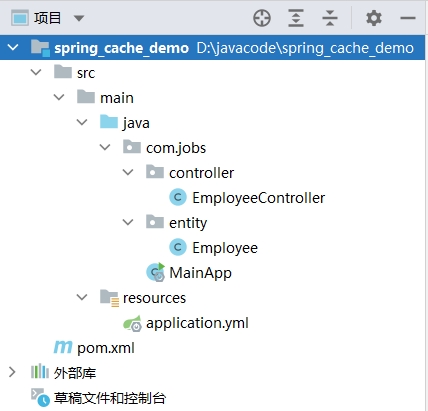SpriingCache 实现了基于注解的缓存功能,只需要在方法上添加注解即可实现常用的缓存功能,大大简化了的业务代码的实现。SpringCache 默认集成于 SpringContext 中,这意味着对于使用 SpringBoot 框架来说,不需要引入额外的 jar 包即可使用。
SpringCache 通过 CacheManager 接口来统一不同的缓存技术,底层可以切换不同的 cache 实现。默认采用 ConcurrentMapCacheManager 实现缓存功能。如果想使用 Redis 作为缓存,只需要在 Springboot 程序中引入 Redis 的起步依赖即可自动切换到 RedisCacheManager。
下面就让我们体验一下 SpringCache 的具体功能吧,在博客的最后会提供源代码下载。
一、搭建工程
搭建一个 SpringBoot 程序,结构如下所示:

pom 文件的具体内容如下:
<?xml version="1.0" encoding="UTF-8"?>
<project xmlns="http://maven.apache.org/POM/4.0.0"
xmlns:xsi="http://www.w3.org/2001/XMLSchema-instance"
xsi:schemaLocation="http://maven.apache.org/POM/4.0.0
http://maven.apache.org/xsd/maven-4.0.0.xsd">
<modelVersion>4.0.0</modelVersion>
<parent>
<groupId>org.springframework.boot</groupId>
<artifactId>spring-boot-starter-parent</artifactId>
<version>2.7.10</version>
</parent>
<groupId>com.jobs</groupId>
<artifactId>spring_cache_demo</artifactId>
<version>1.0-SNAPSHOT</version>
<properties>
<java.version>1.8</java.version>
</properties>
<dependencies>
<dependency>
<groupId>org.springframework.boot</groupId>
<artifactId>spring-boot-starter-web</artifactId>
<scope>compile</scope>
</dependency>
<dependency>
<groupId>org.projectlombok</groupId>
<artifactId>lombok</artifactId>
<version>1.18.20</version>
</dependency>
</dependencies>
<build>
<plugins>
<plugin>
<groupId>org.springframework.boot</groupId>
<artifactId>spring-boot-maven-plugin</artifactId>
</plugin>
</plugins>
</build>
</project>
可以发现除了 web 实现必须要引用的 spring-boot-starter-web 起步依赖和 lombok 之外,没有引入额外的 jar 包。其中 lombok 不是必须要引入的,之所以引入是为了简化实体对象的创建,以及使用其 lombok 自带的日志打印功能。
本博客的 Demo 使用的实体类 Employee 细节如下:
package com.jobs.entity;
import lombok.Data;
import java.io.Serializable;
//每个实体类,最好实现 Serializable 接口,否则可能会出错
@Data
public class Employee implements Serializable {
private String name;
private int age;
}
这里需要注意的是:所有实体类最好实现 Serializable 接口,比如对于大部分的 CacheManager 的实现是基于 jdk 的序列化,要求实体类必须实现 Serializable 接口,否则在使用 SpringCache 的过程中就会报错。
对于 application.yml 配置文件,内容很简单,只配置了启动端口,如下所示:
server:
port: 8888
二、使用默认的缓存功能
SpringCache 是基于注解的缓存实现,常用的注解有:
- @EnableCaching 这个注解需要在 SpringBoot 启动类上添加后,才能使用 SpringCache 的其它注解
- @Cacheable 在方法执行前先查看是否有相应缓存,有则直接返回缓存,无则调用方法并将方法返回值放到缓存中
- @CachePut 方法执行完毕后,将结果添加到缓存中
- @CacheEvict 删除一条或所有缓存
首先我们需要在 SpringBoot 的启动类上,添加 @EnableCaching 注解。
package com.jobs;
import org.springframework.boot.SpringApplication;
import org.springframework.boot.autoconfigure.SpringBootApplication;
import org.springframework.cache.annotation.EnableCaching;
@EnableCaching
@SpringBootApplication
public class MainApp {
public static void main(String[] args) {
SpringApplication.run(MainApp.class, args);
}
}
然后在 EmployeeController 中编写用于测试的接口,具体细节如下:
package com.jobs.controller;
import com.jobs.entity.Employee;
import lombok.extern.slf4j.Slf4j;
import org.springframework.beans.factory.annotation.Autowired;
import org.springframework.cache.Cache;
import org.springframework.cache.CacheManager;
import org.springframework.cache.annotation.CacheEvict;
import org.springframework.cache.annotation.CachePut;
import org.springframework.cache.annotation.Cacheable;
import org.springframework.web.bind.annotation.*;
import java.util.Random;
@Slf4j
@RequestMapping("/employee")
@RestController
public class EmployeeController {
@SuppressWarnings("SpringJavaInjectionPointsAutowiringInspection")
@Autowired
private CacheManager cacheManager;
//当接收到的参数封装的实体不为 null 时,添加缓存。(condition 表示满足条件时,对执行结果进行缓存)
// key 不存在时,添加缓存,如果 key 存在时,则更新缓存
// #emp.name 表示使用接收到的实体对象的 name 作为 key
// #result.name 表示使用返回的结果对象的 name 作为 key
//@CachePut(value = "employee", key = "#emp.name", condition = "#emp != null")
@CachePut(value = "employee", key = "#result.name", condition = "#emp != null")
@PostMapping
public Employee addEmployee(@RequestBody Employee emp) {
log.info("addEmployee 传入的参数:" + emp);
if (emp != null) {
return emp;
} else {
return null;
}
}
//使用接收到的参数 name 作为 key
//当返回结果不是 null 时,进行缓存。(unless 表示不满足条件时,对执行结果进行缓存)。
//当 key 存在时,直接返回缓存中的数据
@Cacheable(value = "employee", key = "#name", unless = "#result == null")
@GetMapping("/{name}")
public Employee getEmployee(@PathVariable String name) {
log.info("getEmployee 传入的参数:" + name);
if (name == null || name.length() == 0) {
return null;
} else {
Employee emp = new Employee();
emp.setName(name);
emp.setAge(new Random().nextInt(100));
return emp;
}
}
//删除缓存,使用接收到的参数 name 作为 key 进行删除
@CacheEvict(value = "employee", key = "#name")
@DeleteMapping
public void deleteEmployee(String name) {
log.info("deleteEmployee 传入的参数:" + name);
}
//查看缓存(对于 Redis 来说,该方法不可用,
//因为基于 redis 的 Cache 具体实现类,没有实现 Serializable 接口)
@GetMapping("/cache")
public Cache viewCache(String key) {
Cache cache = cacheManager.getCache("employee");
if (cache != null) {
return cache;
} else {
return null;
}
}
}
这里需要注意的是:@Cacheable 、@CachePut、@CacheEvict 这些注解的 value 值表示的是缓存的类别。
然后启动 SpringBoot 程序,使用 Postman 工具模拟 http 请求接口来测试,想要查看缓存,可以请求 localhost:8888/employee/cache 接口进行验证,由于 SpringCache 默认使用 ConcurrentMapCacheManager 在内存中保存缓存数据,因此重启 SpringBoot 程序后,缓存就消失了。
三、使用 Redis 缓存
上面的代码不需要进行任何更改,只需要引入 Redis 的起步依赖,然后在 application.yml 增加 Redis 的配置即可。
1 在 pom 文件中添加 Redis 的起步依赖
<dependency>
<groupId>org.springframework.boot</groupId>
<artifactId>spring-boot-starter-data-redis</artifactId>
</dependency>
2 在 application.yml 中添加 Redis 的配置
spring:
redis:
host: 192.168.216.128
port: 6379
# redis 的连接密码,如果没有密码,可以省略
password: redis123
# redis 默认 16 个库,可选编号为 0 到 15,默认就是 0
database: 0
cache:
redis:
time-to-live: 1800000
然后继续使用 Postman 工具进行接口测试,此时直接在 Redis 中查看结果进行验证。
本篇博客的源代码下载地址:https://files.cnblogs.com/files/blogs/699532/spring_cache_demo.zip